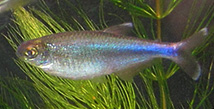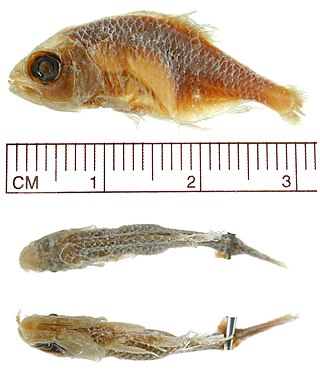
The black neon tetra is a freshwater fish of the characin family (Characidae) of the order Characiformes. It is native to the Paraguay basin of southern Brazil. They are often found in the aquarium trade.
The pink corydoras is a tropical freshwater fish belonging to the subfamily Corydoradinae of the family Callichthyidae. It originates in inland waters in South America, and is found in the Meta River basin in Colombia. A maximum body length of 4.2 cm has been reported. It was named in honor of pet-book publisher Herbert R. Axelrod (1927–2017), who helped collect type series and sent it to the Senckenberg Museum in Frankfurt, Germany.

Sundadanio axelrodi is a danionin in the family Cyprinidae, with origin from Borneo, Bangka, and Sumatra. Originally described as a rasbora, Rasbora axelrodi, this tiny species was later deemed to be more closely related to the danios but not enough to be moved into the genus Danio. Sundadanio axelrodi reaches a maximum size of 1.7 cm. Sundadanio was considered monotypic until the genus was reassessed by Conway, Kottelat and Tan in 2011.

Cynotilapia axelrodi is a species haplochromine cichlid which is endemic to Lake Malawi where it occurs in Nkhata Bay and Chirombo Point, Malawi.
The ruby tetra is a species of freshwater fish in the family Characidae. It is found in the Río Meta, Colombia, South America. In nature, it has a natural red colour, but this is somewhat lessened in captivity. Ruby tetras grow up to 4 cm (1.6 in) long.

The gold tetra is a species of small freshwater fish in the family Characidae native to lowland South America, where they are abundant in coastal floodplains. Their name comes from a powdery golden tint on their body that is thought to be caused by internal parasites. Gold tetras are peaceful, hardy, schooling community fish. Gold tetras have been successfully bred in captivity.

Knodus borki is a species of characin endemic to Peru, where it is found in the vicinity of Iquitos. It is found in a freshwater environment within a benthopelagic depth range. This species is native to a tropical environment. It lives in the habitats of rivers, streams, and tributaries.
Axelrodia is a genus of small characin from the Amazon Basin and Meta River in South America, with three currently described species:
Brittanichthys is a genus of characins endemic to the Rio Negro basin in South America. The currently described species are:
Carlana is a genus of freshwater fish in the family Characidae. It contains the single species Carlana eigenmanni, which is found in Costa Rica, Nicaragua and Panama. The maximum standard length is 5.4 centimetres (2.1 in).

The royal tetra is a species of characin endemic to Brazil, where it is found in tributaries of the Aripuanã River. It is the sole member of its genus.
Lophiobrycon weitzmani is a species of small characin endemic to Brazil, where it is found in the upper Paraná River basin. It is considered threatened by Brazil's Ministry of the Environment. This species is the only member of the genus Lophiobrycon, but it is closely related to Glandulocauda and Mimagoniates.
Mixobrycon ribeiroi is a species of characin endemic to Paraguay, where it is found in the Paraguay River basin. It is the only member of its genus.

Psellogrammus is a genus of freshwater fish in the family Characidae. It contains the single species Psellogrammus kennedyi, which occurs in Argentina, Brazil, and Paraguay. It is found in the Paraguay and São Francisco River basins.
Gerald Robert "Gerry" Allen is an American-born Australian ichthyologist. His career began in 1963, when he spent a semester at the University of Hawaii, where he also received a PhD in marine zoology in 1971. In 1972, Allen wrote his doctoral thesis on the systematics and biology of the anemone fish.
Heiko Bleher is a German researcher, author, photographer, and filmmaker. He is best known in the scientific community for his contribution to the exploration of fresh and brackish water habitats worldwide. He has discovered numerous species of fish and aquatic plant, several of which carry his name or are named in honor of Bleher's family.
Hyphessobrycon arianae is a species of tetra in the family Characidae. It is native to the Paraná River basin. It can grow to a length of about 2.5 centimeters.
Hyphessobrycon axelrodi is a species of tetra in the family Characidae.

Hyphessobrycon boulengeri is a species of tetra belonging to the family charicidae. It is native to South America. It inhabits the Rio Grande do Sul, Brazil.
Phenacogrammus bleheri is a species of fish in the African tetra family. It is known only from a small tributary of the Bari River in the Lua River system in the Ubangi River drainage, in the middle Congo River basin in the Democratic Republic of the Congo. This species reaches a length of 6.3 cm (2.5 in).







